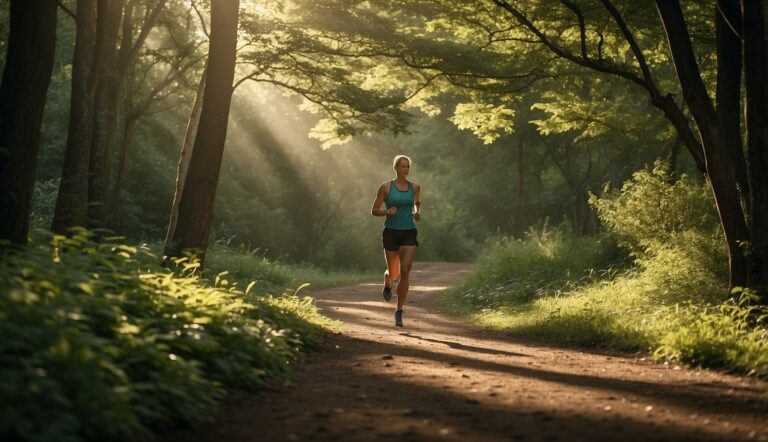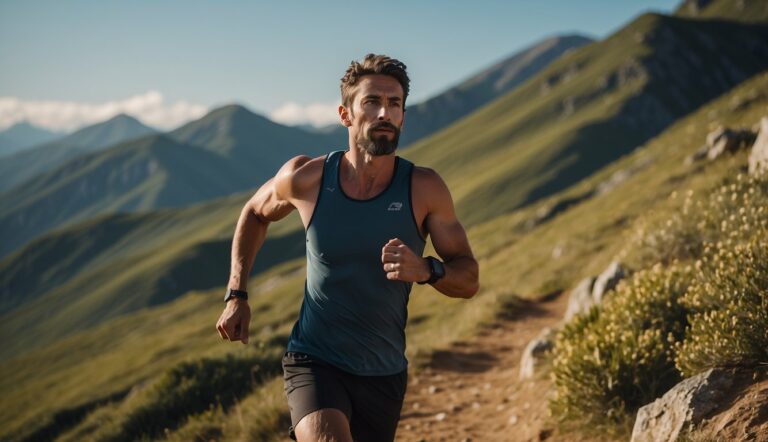Trail Running Gait Analysis: Optimize Your Form for Better Efficiency
Trail running demands a unique blend of strength, agility, and endurance, making the analysis of one’s running gait an essential practice for improving form and efficiency. As a UESCA certified running coach with extensive experience in gait analysis, I’ve learned that the uneven terrain of trails requires runners to adapt their technique for optimal performance. Adjusting your running gait can lead to a smoother stride, reduced injury risk, and better running economy, which is how much energy you expend while running.
Gait analysis specifically tailored for trail runners focuses on identifying movement patterns that may be inefficient or prone to causing injuries. Through assessing aspects like foot strike, leg swing, and overall posture, I help runners make informed adjustments to their form. Simple changes, such as optimizing stride length or improving the symmetry of arm swings, can result in significant performance enhancements. Performing a trail running gait analysis is not about achieving a ‘perfect’ running form, as each runner’s body mechanics are unique, but about finding the most effective stride for you as an individual.
By refining your running mechanics, you can run longer and stronger on the trails. Small, continuous adjustments to your form can lead to lasting improvements in running efficiency, which is particularly crucial in trail running where energy conservation is key. Integrating strength and flexibility exercises with targeted technique modifications can unlock a more effective running gait, helping you enjoy the trails with greater ease and less fatigue.
Trail Running Biomechanics, Form, and Gait for Trail Runners
In trail running, having a firm grasp of biomechanics and an efficient running gait are essential in enhancing running economy and achieving optimal performance without injury.
The Basics of Running Gait
Running gait refers to the series of motions that occur during a running stride. For trail runners, variations in terrain mean that gait is less consistent than in road running. I help runners focus on maintaining a stable and adaptive stride to navigate uneven surfaces efficiently.
- Stance Phase: The foot is in contact with the ground.
- Swing Phase: The foot is off the ground and moving forward.
Key Components of Running Biomechanics
Running biomechanics involve understanding the mechanical aspects of the human body in motion. By examining these, I can pinpoint areas for improvement and strategies to maintain efficiency.
- Joint Kinematics: Describes the motion of joints during the run.
- Muscle Function: Essential for producing force and absorbing shock.
The goal in analyzing these components is to boost the body’s ability to run effectively, using less energy, which directly impacts your running economy.
Conducting an Effective Gait Analysis for Trail Runners

Gait analysis for trail runners is an insightful approach to refine technique for efficiency and injury prevention. In my coaching experience, the key is utilizing the right tools and understanding the data they provide.
Equipment and Technology for Gait Analysis
Camera: For capturing the running gait cycle, a high-speed camera is essential. It should record at least 120 frames per second to accurately analyze motion. Ensure the camera is positioned laterally to the path of the run for a side view.
- Position: 15 meters away, at hip level
- Lighting: Consistent, without shadows or glare
Wearable Technology: Advanced devices can provide real-time feedback on the runner’s mechanics. They range from simple pedometers to sophisticated sensors that attach to footwear or the body.
Software: Post-recording, use analysis software that can provide frame-by-frame breakdowns of the running cycle.
| Equipment | Purpose |
|---|---|
| High-speed camera | Capturing detailed gait cycle |
| Wearable sensors | Providing real-time biomechanical feedback |
| Gait analysis software | Detailed review and frame-by-frame analysis |
Interpreting Video Assessments
Review the video in slow motion to observe the key phases of the running gait cycle. Look for:
- Initial Contact: Is the foot landing too far in front of the center of mass (overstriding)?
- Midstance: Is there proper alignment of the knee over the foot?
- Propulsion: Are the toes pointing straight ahead during push-off?
Make notes of any discrepancies, especially those repeated with each stride, which can indicate areas needing correction.
Motion Analysis and Data Interpretation
Gait analysis yields quantifiable data. I break down this data to assess:
- Stride Length: Overly long or short strides can lead to inefficiency.
- Cadence: Not too high or low—it’s about finding an optimal turnover.
- Foot Strike: The part of the foot making first contact and its impact on the running motion.
- Arm Swing: Coordination with legs and overall balance.
By mapping these details, I develop a clear picture of my athlete’s gait characteristics and potential areas for improvement.
Improving Running Technique for Efficiency and Injury Prevention

I understand the crucial balance between running efficiency and injury prevention. Enhancing your form is not just about speed; it’s about making your body work smarter. Let’s delve into key strategies.
Optimizing Foot Strike and Cadence
Foot Strike: My focus is on enabling you to identify whether you’re a forefoot, midfoot, or heel striker and adjusting accordingly to reduce impact forces.
- Forefoot Strikers: Reduced heel impact but potential for calf strain.
- Midfoot Strikers: Often considered the most balanced strike pattern.
- Heel Strikers: Can lead to higher impact forces on the joints but is common among endurance runners.
Cadence: Aim for a cadence around 180 steps per minute, which many consider optimal. Increased cadence can diminish stride length and minimize the load on your joints.
Body Alignment and Posture
Maintaining proper posture while running conserves energy and prevents muscle fatigue.
- Head: Keep your gaze forward and neck aligned with your spine.
- Shoulders: Relax your shoulders to reduce tension.
- Torso: A slight forward lean comes from the ankles, not the waist, to propel forward motion.
Proper alignment is key to efficient running, reducing drag, and preventing injuries.
Importance of Hip and Trunk Stability
Strong hips and a stable trunk form the core of a solid running style.
- Hip Stability: Hip muscles support the pelvis and keep your stride aligned. Weak hips can lead to injuries like IT band syndrome.
- Trunk Stability: A strong core maintains posture and reduces excess movement, translating into better energy efficiency.
Exercises like planks and side leg lifts enhance stability, offering a more robust platform for your running mechanics.
Tailoring Training for Optimal Gait Mechanics
To enhance your trail running efficiency and reduce injury risk, it is crucial to refine your gait mechanics through targeted training. My coaching philosophy integrates specific strength and conditioning exercises with flexibility and mobility work to create a holistic approach that improves your running technique.
Strength and Conditioning Exercises
Strength is the foundation of robust running mechanics. Aim to develop power and stability in your lower body which is essential for propelling yourself efficiently over uneven terrain. Here’s a routine I recommend to build running-specific strength:
- Squats (3 sets of 10 reps): Strengthen your quads, hamstrings, and glutes.
- Single-Leg Deadlifts (3 sets of 8 reps per leg): Enhance balance and activate your posterior chain.
- Calf Raises (3 sets of 15 reps): Build calf strength for better push-off power.
Incorporate these exercises twice a week to see improvements in your running form and efficiency.
Flexibility and Mobility Work
Flexibility and mobility are integral to maintaining a fluid stride and avoiding injuries. A focused routine enhances the range of motion, which in turn contributes to optimal gait mechanics. Include the following in your daily training:
- Dynamic Leg Swings (3 sets of 10 reps per leg): Increase hip mobility.
- Lunge with a Twist (3 sets of 8 reps per leg): Promote thoracic and hip mobility.
- Downward Dog (hold for 30 seconds): Stretch the calves, hamstrings, and back.
Remember, flexible and mobile muscles are less prone to strain and facilitate a more natural running motion.
Addressing Common Gait-Related Running Injuries
In my experience as a UESCA certified running coach, tackling gait-related injuries effectively requires a strategic approach to rehabilitation combined with preventative practices. Proper attention to these areas can significantly reduce pain and the risk of further injury.
Strategies for Injury Rehabilitation
To expedite recovery and mitigate the recurrence of injury, I’ve identified two key strategies:
Targeted Muscle Balance:
- Strengthening: Incorporate exercises for weaker muscles that may be contributing to the imbalance.
- Stretching: Focus on tight muscles to alleviate undue stress on joints.
Gait Retraining:
- Technique Adjustment: Work on foot strike and body alignment during runs.
- Form Drills: Perform running drills that promote efficient movement patterns.
Preventative Measures and Tips
Prevention is paramount to avoid gait-related injuries, and here’s how:
- Proper Running Shoes: Ensure shoes provide adequate support and are suited to your running style.
- Risk Factor Awareness: Be cognizant of issues such as overstriding and understand your personal injury history.
- Regular Assessment: Engage with a professional for gait analysis periodically to catch potential issues early.
By keeping these strategies and tips in mind, you can maintain a healthy running form and stay clear of injuries that might otherwise sideline your trail running adventures.





